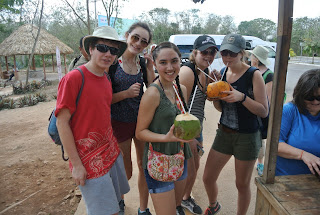For the past two days we have been traveling around the peninsula and seeing some pretty amazing sites. Our first morning was an early one, at 6:30am we rode bikes to see a milpa, the traditional form of rotation agriculture in the Yucatan.
 |
| It was a beautiful, cool morning |
 |
| With our guides |
 |
| After breakfast we headed off to the Mayan ruins, but had time to braid hair in the van! |
 |
| We had some coconuts first to keep our energy up for all the walking! |
 |
| Karla explains a little bit about the archaeological site |
 |
| The group at the base of a ceiba, the sacred tree of the Mayans. We thunked it a few times to hear the sound the hollow trunk makes. |
 |
| This tree was thought to connect the heavens with the earth and the underworld |
 |
| Exploring ancient bedrooms |
 |
| Karla explains the estella which was an announcement written in stone to tell the people of a new ruler or conquest |
 |
| Getting ready to climb to the top of the big pyramid! |
 |
| They're going to make it! |
 |
| We met some Mayans on the way out and took the opportunity to take a few fun pictures. |
 |
| These young men dress up as Mayans from long ago, but they really are Mayan and still speak their native language |
 |
| They live in the next town over, which shares a name with the Mayan ruins. We even saw one fixing his roof later that evening! |
 |
 |
| Then it was time for another bike ride, but this time to a refreshing cenote! |
 |
| In the afternoon we tried our hand at hammock weaving |
 |
| A very tranquilo activity |
 |
| Different students tried out different weaving techniques |
 |
| And they had some fun chatting with their hosts, too! |
 |
| While we were walking around it started to pour, but we caught a picture of the rainbow before running for cover! |
 |
| They learned quickly! |
 |
| And some even bought hammocks from their instructors! |
 |
| The next morning we said goodbye to the eco-cabins and headed to Ria Lagartos for a tour of the mangroves and salt flats. |
 |
| On our way back into the city we stopped at the general cemetery of Merida, which has a lot of very important people buried there. |
 |
| We learned a little about the story of Felipe Carillo Puerto, the first socialist governor of Yucatan who translated the constitution into Mayan and began returning land to the native people. |
 |
| Then we had some time to explore |
 |
| A HUGE thank you to our driver for two wonderful days of exploration. Hasta luego! |













